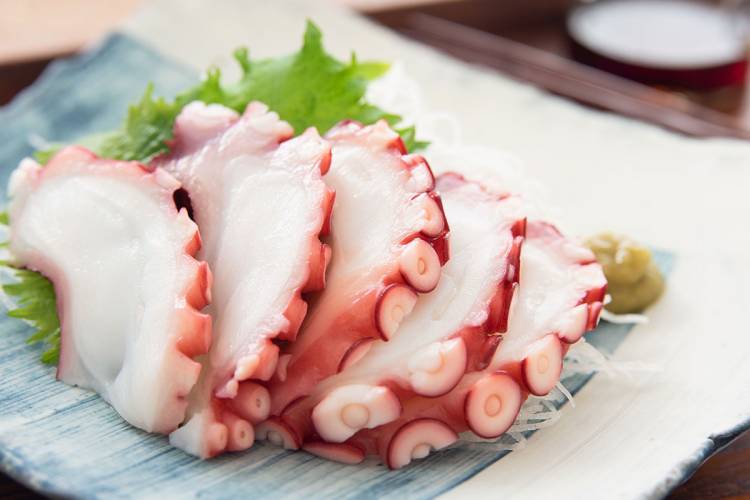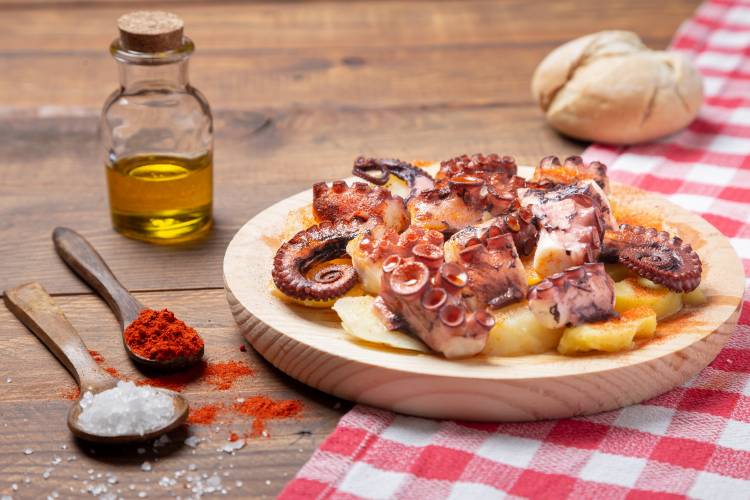Properties of octopus
Do you know what the properties of octopus are? There are many benefits of eating this mollusc: it is a source of minerals, vitamins and healthy fats. Discover them all!
fresh food
Share

Octopus is a type of cephalopod mollusc which features a large head, from which eight tentacles extend with suction cups of different sizes to enable it to move and trap its prey. Depending on the type of species, its colour varies between brown and a reddish colour. Although there are different varieties of octopus around the world, only some of them are edible; specifically, in Spain, the most widely consumed type is the common octopus or Octopus vulgaris, which is found in the waters of the Atlantic or the Mediterranean.
The meat is highly sought after, not just because of its excellent taste, but also for its
nutritional properties.
What are the benefits of octopus?
- It boasts a high level of proteins of a high biological value
- It is low in fats and cholesterol and it is also very low in calories: 70 calories for every 100 grammes.
- A portion of octopus (200g) covers 100% of the recommended daily allowance (RDA) of selenium for men and women aged between 20 and 39, doing moderate physical activity. For their part, levels of iodine, phosphorous, calcium and sodium equate to 80%, 38%, 22% and 28% respectively and of the RDA for each of them. They are followed by zinc (18%), iron (20%) and magnesium (13%).
- The largest vitamin content comes from vitamin B12; in considerable quantities, niacin and vitamin B6 and, in smaller quantities it includes thiamine, vitamin A and E.
- ts high water content, high presence of proteins and low fat content, help to control weight. Additionally, it is a filling food and 100g of octopus provides 20% of the recommended daily allowance of protein.

Galician style octopus recipe
Although many recipes include octopus, one of the most famous dishes from Spanish gastronomy is Galician style octopus, or ‘pulpo a la gallega’. If you still don’t know how to make it....make a note of this famous recipe!
Ingredients
- 1 octopus weighing approx. 2 kg (it can be fresh octopus or frozen octopus)
- 5 potatoes or small boiled potatoes (whichever you prefer).
- Intense olive oil
- Sea salt or Maldon sea salt
- La Vera paprika or sweet paprika
Step by step method
- Clean the octopus: remove the entrails from inside, to do so you will need to turn the head over and clean the inside; then, cut the mouth with kitchen scissors and rinse the octopus thoroughly after completing this process.
- Freeze the octopus for 48 hours: this step is carried out to ensure the octopus isn’t tough, but if you buy it already frozen, you can ignore this step.
- Boil the octopus gradually: put a large pan on the hob to boil; when the water has reached boiling point, insert the octopus (except for the head) for a few seconds and repeat the process 3 or 4 times to soften the tentacles. Afterwards, insert the whole octopus into the pan for an additional 20 minutes, more or less, or until you think it is cooked enough. When cooked, switch off the hob and leave it in the hot water for another 20 minutes so it softens completely.
- Cook the potatoes: you don’t need to do this step if you buy pre-cooked potatoes. Otherwise, boil the potatoes in the same way as you usually would.
- Dish up your Galician style octopus: cut the potatoes into slices and place on the dish. Cut the octopus into cubes or slices and place them on top of the potatoes. Drizzle with your preferred extra virgin olive oil, Maldon sea salt and sweet paprika, pierce it with wooden cocktail sticks… and enjoy your Galician style octopus!






